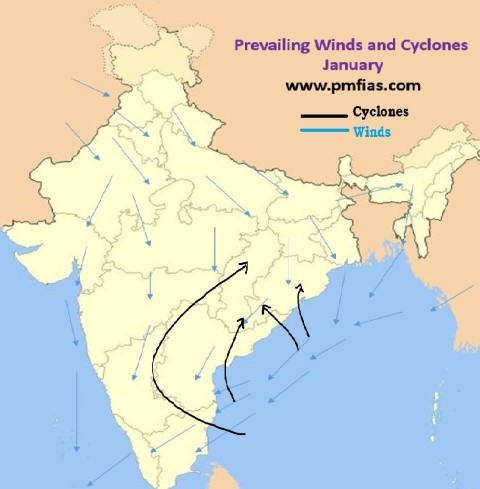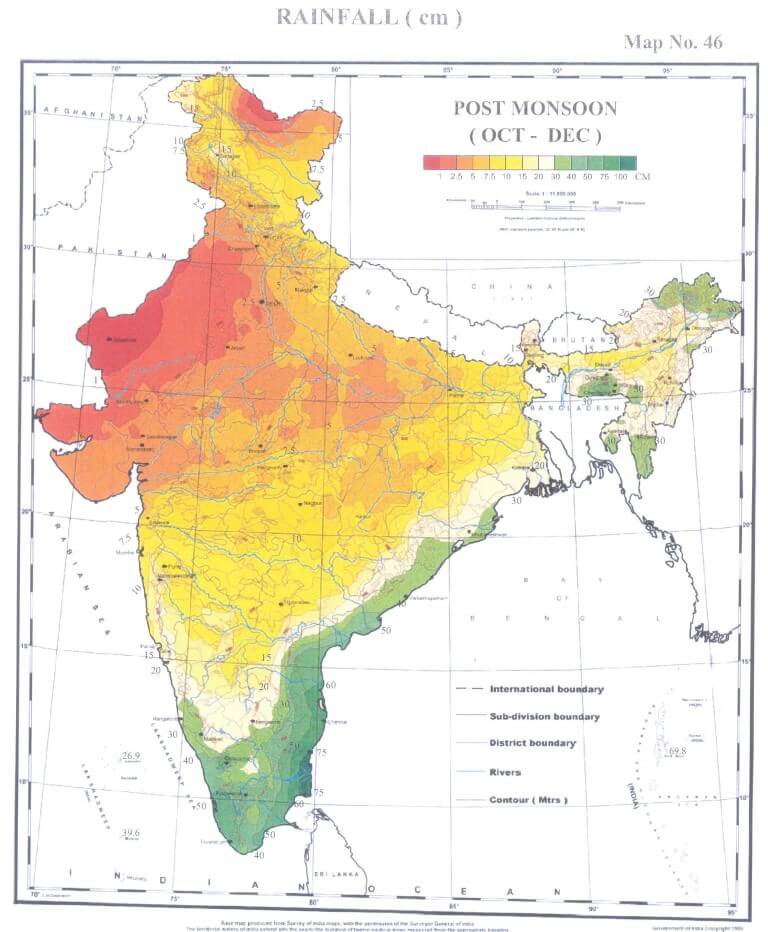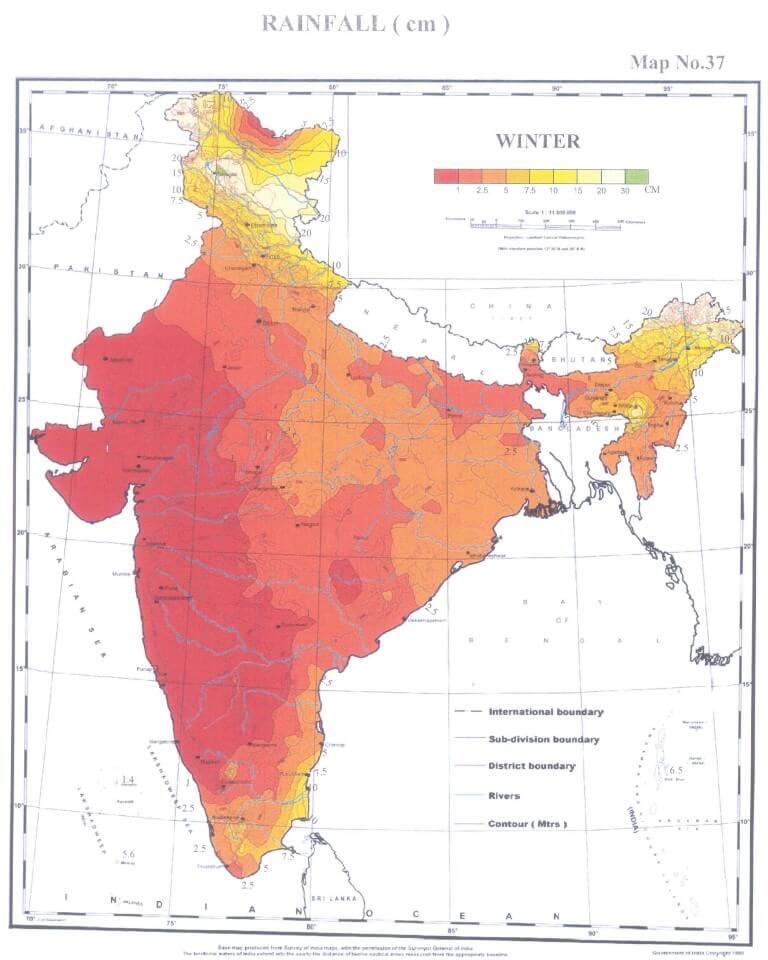Indian Climate: Retreating Monsoon Season (North East Monsoons)
Table of Contents
North East Monsoon Season – Retreating Monsoon Season – Temperature, Cyclones & Precipitation during Retreating Monsoon Season. Annual Rainfall.
Retreating Monsoon Season – North East Monsoon Season
- Starts with the beginning of the withdrawal of southwest monsoon [middle of September – November] and lasts till early January.

- The monsoons withdraw from the extreme north-west end of the country in September, from the peninsula by October and from the extreme south-eastern tip by December.
- In Punjab the south-west monsoons reach in the first week of July and withdraw from there in the second week of September.
- The south-west monsoons reach Coromandel coast in the first week of June and withdraw from there only in the middle of December.
- Unlike the sudden burst of the advancing monsoons, the withdrawal is rather gradual and takes about three months.
Temperature during Retreating Monsoon Season
- With retreat of the monsoons, the clouds disappear and the sky becomes clear.
- The day temperature starts falling steeply.
- The diurnal range of temperature increases due to lack of cloud cover.
Pressure and Winds during Retreating Monsoon Season
- As the monsoons retreat, the monsoon trough weakens and gradually shifts southward. Consequently the pressure gradient is low.
- Unlike south-west monsoon, the onset of the north monsoon is not clearly defined.
- The direction of winds over large parts of the country is influenced by the local pressure conditions.
Cyclones during Retreating Monsoon Season
- Most severe and devastating tropical cyclones originate in the Indian seas especially in the Bay of Bengal.
- The highest frequency of the cyclones is in the month of October and the first half of November.
More cyclones are born in October and then in November and more cyclones originate in the Bay of Bengal than in the Arabian Sea.
- In October, the Cyclones of the Bay of Bengal originate between 8°N and 14°N.
- Initially they move in a west or northwesterly direction, but many of them later recurve and move towards the north-east.
- Near 55 per cent of the Bay storms cross or affect the Indian coast.
- The area’s most vulnerable to these storms include the coastal belts of Tamil Nadu, Andhra Pradesh, Odisha and West Bengal.
- Many of the cyclones which strike the eastern coast of India, south of 15°N latitude cross the southern Peninsula and enter Arabian Sea.
- During this process, they may weaken, but on re-entry over the Arabian sea they intensify into cyclonic storms.
- The storms of Arabian sea originate between 12°N and 17°N latitudes in October and between 8° N and 13° N latitudes in November.
- Generally they move away from the coast in a north-westerly direction. But about 25% of them later recurve northeast and strike the Maharashtra or Gujarat coast.
- In north-west India the western disturbances produce clouding and light rainfall in the otherwise fine weather.
- The precipitation is in the form of snow in higher reaches of Jammu and Kashmir, Himachal Pradesh and in Kumaon Hills.
Precipitation during Retreating Monsoon Season
- The humidity and cloud cover are much reduced with the retreat of the south-west monsoons and most parts of the country remain without much rainfall.
- October-November is the main rainy season in Tamil Nadu and adjoining areas of Andhra Pradesh to the south of the Krishna delta as well as a secondary rainy period for Kerala.
- The retreating monsoons absorb moisture while passing over the Bay of Bengal and cause this rainfall.
Annual Rainfall [South West Monsoons + Retreating Monsoons]
Areas of very high rainfall
- Areas receiving an annual rainfall of 200 cm and above.
- These include western side of Western Ghats [Thiruvananthapuram in the south to Mumbai in the north].
- The average annual rainfall in this belt is 200-400 cm.
- Assam, Nagaland, Meghalaya, Mizoram, Arunachal Pradesh, Sikkim, parts of Manipur, Tripura and north-eastern tip of West Bengal also receive 200 cm or more, with isolated pockets receiving over 400 cm.
Meghalaya (the abode of clouds) is the wettest part of the country with Mawsynram and Cherrapunji getting 1,221 and 1,102 cm of annual rainfall respectively.
Areas of high rainfall
- 100-200 cm annual rainfall.
- Eastern slopes of the Western Ghats, major part of the northern plain, Odisha, Madhya Pradesh, Andhra Pradesh and Tamil Nadu.
Isohyet (the line joining places of equal rainfall).
Areas of low rainfall
- 50-100 cm annual rainfall.
- Large parts of Gujarat, Maharashtra. western Madhya Pradesh, Andhra Pradesh, Karnataka, eastern Rajasthan, Punjab, Haryana and parts of Uttar Pradesh.
Areas of very low rainfall
- These are desert and semi-desert areas receiving less than 50 cm of annual rainfall.
- They include large areas of western Rajasthan, Kachchh and most of Ladakh region of Jammu and Kashmir.


No comments:
Post a Comment